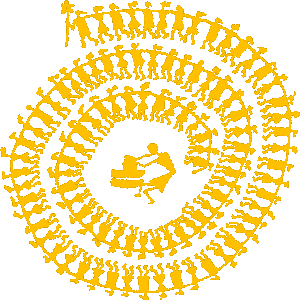Challenging Ideological Hegemony
Remaking Our Conceptual Maps of the World
by Harry Targ
I read about the dangers of federal deficit, the connection between markets and democracy, capitalist institutions and human well-being, insurance  companies and quality health care, and the historic victories for peace and justice resulting from killing Osama bin Laden, and the son and grandchildren of Muammar Gaddafi.
companies and quality health care, and the historic victories for peace and justice resulting from killing Osama bin Laden, and the son and grandchildren of Muammar Gaddafi.
I am reminded of Antonio Gramsci’s perceptive analysis about how people are ruled as much by what they learn to think and believe as by the use of force. Ideological hegemony refers to the idea systems that ruling classes construct to create willing and pliant citizens in political regimes that lack moral legitimacy or economic rationale.
I am also reminded of theorists from the neo-Marxist Frankfurt School, particularly Herbert Marcuse, who wrote about how the fundamental contradictions in peoples’ lives — capitalists versus workers and rule by the few versus the possibility of the rule by all — are transformed into a unanimity of thinking among people whose interests should make them adversaries and not collaborators. I thought that Marcuse’s postulate of a “one-dimensionality†in political thinking in the United States was exaggerated — lots of Americans, particularly the exploited and oppressed, identified far less with the United States in its war on the Vietnamese people than was believed. It was the lack of ideological homogeneity that exacerbated the campaigns of the ideological institutions — media, education, and political process — to try to construct it.
Ken Kesey, in One Flew Over the Cuckoo’s Nest, used an interesting metaphor for society: a ward in an institution for the mentally ill ruled by a nurse who sought to dominate the patients through discipline, sedation, and the projection of the belief system that any independent thought was pathological. Somewhere in the novel Kesey refers to an ideological “fog machine.†The reader could almost feel how the patients of the mental ward experience the thick and blinding fog in the air, hampering vision and even breath. Kesey gives the reader hope by describing the arrival of a new patient in the ward, Randle McMurphy, who sees through the fog machine and commits his life to helping his fellow inmates rebel against it. While he personally does not survive the struggle, some of the most docile of inmates escape, destroying the ideological hegemony of the system.
I am also reminded of the great Hoosier writer Kurt Vonnegut, who describes an Indiana woman who roams through airplanes looking for Hoosiers. Vonnegut describes her quest as pursuit of a “false karass.†It is false because there is nothing about being a Hoosier that automatically leads to shared interests.
For years we have been sold an ideological package of lies. The recent rendition begins with 9/11. The world consists of large numbers of persons of color, especially Muslims, who want to kill us. We need to kill them first. Preemptive attack on those who we would expect to hate us is OK. International Law says so. U.S. diplomatic history says so.
Why should we be afraid? Why should we be prepared to kill? We must be vigilant because they hate our freedom. They want to destroy the natural evolution of societies from autocracies to market-based democracies. We must be fearful, vengeful, and ready to act for the benefit of the world.
Over the last four months, mass movements emerged projecting very different, even counter-hegemonic ideas about building a better world. Young people, workers, women, and secularists started going out in the streets in Tunisia, Egypt, Yemen, and Bahrain. They demanded democracy and economic justice. They began to mobilize in public spaces, such as schools, union halls, and mosques and churches. They communicated via cell phones and sent messages in shorthand sentences and (to me) incomprehensible letters. The sun and warmth of the Arab Spring blossomed.
In very different places economically, politically, and geographically, the bitter heartland of America, revolt was stirred up as well: Wisconsin, Ohio, Indiana, and Michigan for starters. Workers, students, women, political progressives, health care advocates, and educators began to stand up and say “no†to the steamrolling right-wing political machine, now not too different from the historic “centrist†consensus in U.S. politics. Like their comrades, the heartland radicals too haltingly began to suggest that another world is possible.
So by May Day (what an irony), the United States carried out an assassination mission and killed Osama bin Laden. The media had already begun to salivate over the killings of Gaddafi’s family members. And stories about the need for deficit reduction continue. For both Democrats and Republicans the problem is not capitalism, or neoliberal economic policies. No for them the problem is government. The answer is compromise between a near draconian Obama plan and a right-wing proposal to eliminate most governmental programs, except for the military.
The forces of ideological hegemony say we need to keep our guard up and be prepared to kill those who threaten us or who are claimed to be threats. Criminal justice systems and norms against violence are to be ignored. At home we are to abandon the idea that government must serve the needs of the people.
We must respond to this ideological crusade. While Randle McMurphy in the Kesey novel was a lone actor, progressives need to work together to challenge the fog machine. We need to convince our brothers and sisters that killing and capitalism alike are antithetical to human needs.
Harry Targ teaches foreign policy, US/Latin American relations, international political economy, and topics on labor studies in a Department of Political Science and a program in Peace Studies. He is a member of the Committees of Correspondence for Democracy and Socialism (CCDS), the Northwest Central Labor Council (AFL-CIO), and the Lafayette Area Peace Coalition (LAPC). He regularly blogs at: Diary of a Heartland Radical.
